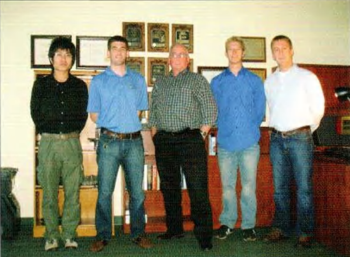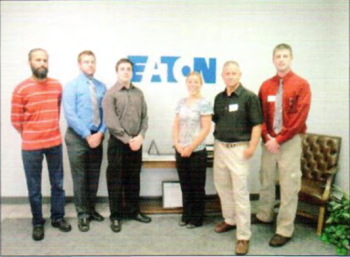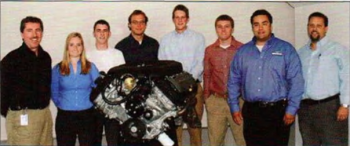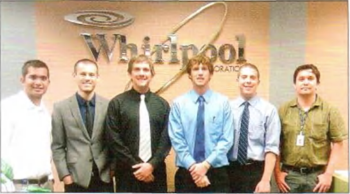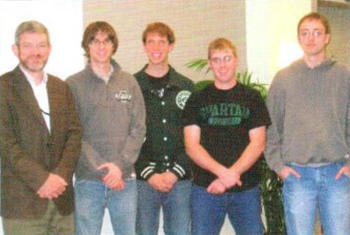Mechanical Engineering
Projects
One goal of the MSU Mechanical Engineering Program is to educate engineers who are prepared to lead, create, and innovate as their professional or graduate careers evolve. The Mechanical Engineering Design Program is the key element of the curriculum that supports this goal. There are five required design courses in the program which provide our students with eight hands-on, team-based, ‘design, test and build’ projects, and numerous opportunities to practice and refine their written, oral, poster, and video presentation skills. The Design Program in Mechanical Engineering has attracted national recognition on many occasions and helps to distinguish the ME program as one of the best in the country.
For information on becoming a project sponsor, please contact Mike Colucci.
The following are the project sponsors and projects for Fall 2010:
Burcham Hills Retirement Community: Movable “Grab Bar” for Senior Apartments
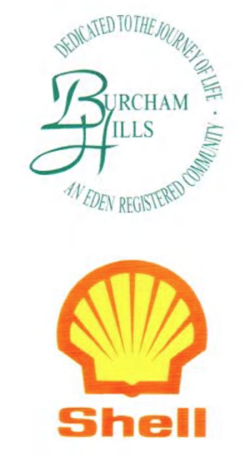 Burcham Hills is a not-for-profit retirement community home that was built in 1974. It is dedicated to providing quality care for residents even as their needs become increasingly demanding. Burcham Hills is home to many residents with various levels of need and does its best to ensure the happiness of its residents by allowing them to rearrange their living quarters to their preference.
Burcham Hills is a not-for-profit retirement community home that was built in 1974. It is dedicated to providing quality care for residents even as their needs become increasingly demanding. Burcham Hills is home to many residents with various levels of need and does its best to ensure the happiness of its residents by allowing them to rearrange their living quarters to their preference.
Burcham Hills has a rehabilitation and health center whose primary goal is to aid in the healing and recovery process of residents and return them to their former level of health and wellbeing as quickly as possible. Burcham Hills is licensed with a Skilled Nursing Facility staff that provides physical, occupational, speech, and recreational therapy.
Currently, caregivers assist residents attempting to move from a seated position to a standing one. This transfer method tends to cause back injuries to caregivers. Also, because there are a limited number of caregivers, residents end up sitting for long periods of time, resulting in bedsores and further deterioration of muscles and motivation. Assisting the seniors in becoming more self-sufficient will improve their lives at Burcham Hills.
A moveable grab-bar that is accessible anywhere in the room will help residents gain independence, prevent bedsores, and reduce the threat of back injuries to caregivers. Research was performed on materials, manufacturing processes, and geometries; and the most effective design was chosen. Computer-aided design programs were then used to model parts and subject them to stress analysis testing. Meeting constraints such as mechanical loading, versatility, maintenance procedures, manufacturability, aesthetics, and cost was essential to the success of the project.
American Hydromech: Fluid Power Application of a Regenerative Turbine Pump
 American Hydromech is a locally owned and operated Michigan business founded by Mr. Timothy A. Droste. American Hydromech specializes in contract and development engineering as well as equipment assembly for land and sea vehicle applications.
American Hydromech is a locally owned and operated Michigan business founded by Mr. Timothy A. Droste. American Hydromech specializes in contract and development engineering as well as equipment assembly for land and sea vehicle applications.
American Hydromech is involved with the development of a new means of powering automotive hydraulic pumps. Existing applications include the use of gear rotor pumps that have developed a reputation for an unpleasant audible noise. It has been shown in other fluid systems, most prominently fuel systems, that hydrodynamic (regenerative turbine) pumps have been successfully implemented. This project will investigate the feasibility of implementing a hydrodynamic pump at low pressure levels to reduce the overall audible noise level in fluid power pumps for automotive applications. In addition to reducing audible noise, the use of a regenerative turbine pump, in conjunction with an electric motor, will allow a greater flexibility of pump performance by making the pump drive independent of engine speed.
The student team was given the task of designing an appropriate fluid circuit system to test the feasibility o f using a regenerative turbine pump in place of a standard gear rotor pump. CAD was used to design the fittings and other assembly components. Utilizing the pump test assembly, several parameters were tested including discharge pressure, pump efficiency, sound pressure, and system flow rate.
Eaton Corporation: Analysis of Magnetic Properties of an Electro-Hydraulic Servo Valve
 Eaton Corporation is a global corporation specializing in powering business systems by manufacturing and distribution of electrical, hydraulic, and mechanical products. The branch of Eaton Corporation based in Jackson primarily manufactures hydraulic power systems. This includes the hydraulic cylinder together with the servo valves
Eaton Corporation is a global corporation specializing in powering business systems by manufacturing and distribution of electrical, hydraulic, and mechanical products. The branch of Eaton Corporation based in Jackson primarily manufactures hydraulic power systems. This includes the hydraulic cylinder together with the servo valves
that control systems.
For a hydraulic system to perform with high precision, good performance of the servo valve is essential. The current model of servo valves has been manufactured for the past 30 years. However, Eaton Corporation has determined that this model does not perform as well as their competitor’s product. This is due to potential issues in the materials, geometry, and tolerances of some of servo actuator components. The goal o f this project is to research materials, machining processes, and tolerances in order to help improve the performance of Eaton’s servo valve.
Our team proposed a number of design changes, based on the outcome of our investigations. These involved varying materials, geometry, and tolerances. The team designed and built a test rig for assessing how the proposed changes affect the response of the servo actuator. This rig measures and evaluates the response of the servo armature using Digital Imaging Correlation, and the results o f the study will be used to recommend design changes for improving the performance of Eaton’s servo valves.
Level 11 Physical Therapy: All Terrain Ambulation and Crawling Body Weight Support System
 Level 11 is a leader in physical therapy rehabilitation to patients with neurological injuries. It is always seeking ways to improve the rehabilitation process while making the recovery more enjoyable and beneficial for the patients it treats. Level 11’s Clinical Director, Bill Thornton, recently designed and patented a body harness that will be used to help patients suffering from paralysis o f the legs to both crawl and walk. The problem is that there is not currently a system on the market that enables both crawling and walking.
Level 11 is a leader in physical therapy rehabilitation to patients with neurological injuries. It is always seeking ways to improve the rehabilitation process while making the recovery more enjoyable and beneficial for the patients it treats. Level 11’s Clinical Director, Bill Thornton, recently designed and patented a body harness that will be used to help patients suffering from paralysis o f the legs to both crawl and walk. The problem is that there is not currently a system on the market that enables both crawling and walking.
The All-Terrain Ambulation and Crawling (ATAC) system will allow patients to either crawl or walk utilizing the new harness. ATAC is an overhead system that accommodates patients of various heights, weights, and strength levels to improve their recovery. This system is an inexpensive alternative to many overhead systems that can cost upwards of $100,000. ATAC is a portable frame that can be utilized both indoors and outdoors. Combined with the body harness, ATAC provides patients anterior and posterior support while craw ling and vertical support while walking. The system features the use of an electric hoist that makes the loading o f patients easier and also provides the therapists the ability to quickly adjust how much support is being provided to the patient during use.
The design team built a prototype of ATAC. It features adjustable arm rests to provide upper body support for patients while walking. The frame design is open at two ends to allow easy access off therapists to assist patients during use. The system was designed using a large factor of safety to ensure the protection and wellbeing of all users. ATAC was created to improve the rehabilitation process for both patients and therapists alike.
Ford Motor Company: Structural Sealing Flange for Thermoplastic Powertrain Components
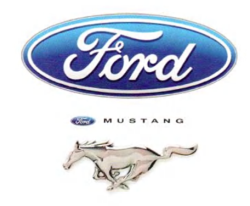 Ford Motor Company is responsible for the building blocks of the automotive industry. From Ford’s Model A creation in 1903, to the release of its latest 5.0 Liter Mustang in 2010. Ford Motor Company has proved it is one of the top automotive companies in the world today. Ford’s striving for excellence in the automotive industry has allowed for new, innovative components for its vehicles each year.
Ford Motor Company is responsible for the building blocks of the automotive industry. From Ford’s Model A creation in 1903, to the release of its latest 5.0 Liter Mustang in 2010. Ford Motor Company has proved it is one of the top automotive companies in the world today. Ford’s striving for excellence in the automotive industry has allowed for new, innovative components for its vehicles each year.
Automotive component design is a competitive and challenging arena in the automotive industry. Automotive suppliers and OEM’s are constantly investigating new innovative ideas and concepts that will increase the overall value of the vehicle to the customer. This project involved creating a new component design, specifically a thermoplastic valve cover sealing flange that could be used on new engine architectures, like the 5.0 Liter Ford Mustang engine.
The team was tasked to create a new sealing flange design that will not only enhance the look of the engine valve cover, but minimize the plastic and fastener usage, while keeping the necessary structural integrity under the gasket pressure.
Computer aided designs were created by the team members and stress analysis, both mathematical and finite element, was performed on each model. Optimization tools were used to maximize the fastener span and minimize the wall thickness of each design to reach the goals set by Ford of decreasing weight and cost to produce a product of high value.
Whirlpool Corporation: LED Panel Optimization and Attachment on an Appliance
 Whirlpool Corporation is a global leader in the manufacturing and marketing o f major home appliances. Whirlpool is a customer- to-customer based company that develops the Whirlpool brand as well as other brands including Maytag. Jenn-Air, KitchenAid, Amana, Brastemp. Estate, and Acros. Through these brands Whirlpool Corporation manufactures appliances that include refrigeration, fabric care, garage organization, cooking, water filtration, and countertop appliances.
Whirlpool Corporation is a global leader in the manufacturing and marketing o f major home appliances. Whirlpool is a customer- to-customer based company that develops the Whirlpool brand as well as other brands including Maytag. Jenn-Air, KitchenAid, Amana, Brastemp. Estate, and Acros. Through these brands Whirlpool Corporation manufactures appliances that include refrigeration, fabric care, garage organization, cooking, water filtration, and countertop appliances.
Currently, Whirlpool Corporation is focusing on basic LED Panel Illumination systems. These systems are facing problems related to light distribution since the LEDs create hotspots. These hotspots cause the inside o f the appliance to lose its aesthetic appeal due to the unevenness o f the light coming from the illuminated panel. LED Panel size and placement constraints are also emphasized. Therefore. Whirlpool Corporation enlisted the help o f the mechanical engineering design team to focus on the LED Panel Illumination for the interior o f a refrigerator.
The design team researched various LED technologies, performed analysis, and built prototypes to find the optimal solution. The main focus related to three important LED factors: power rating, number used, and placement. Through cooperation from Whirlpool Corporation, as well as the faculty advisor, a final design was achieved that optimized light distribution in the LED Panel Illumination module.
Whirlpool Corporation: Non-plumbed Manual Pump Water System for an Appliance
 Whirlpool Corporation is a worldwide leader in the design and implementation o f appliances with a variety of cutting-edge features and technologies. In a growing global economy, the company understands the unique circumstances posed in each of its primary markets and seeks to optimize its designs to enable each of its customers to have access to the very best in product innovation and features.
Whirlpool Corporation is a worldwide leader in the design and implementation o f appliances with a variety of cutting-edge features and technologies. In a growing global economy, the company understands the unique circumstances posed in each of its primary markets and seeks to optimize its designs to enable each of its customers to have access to the very best in product innovation and features.
Many regions of the world do not have the indoor plumbing infrastructure necessary to fully take advantage of all the features of many modern household appliances. The customers in burgeoning economies of countries like Brazil, Russia, India, and China would like to have access to all of the available conveniences from Whirlpool Corporation’s products, including self-dispensing water and ice machines that are incorporated in many of the designs the company offers. In traditional refrigerator design, this feature is dependent on a connection to municipal water lines. It was the intention of Whirlpool Corporation in collaboration with the student design team to build a mechanically driven alternative that would allow the end-user access to the ice-and-water dispensing system without incurring significant added cost.
The team will document the design process and results of different pump setups during bench-top testing while recording the respective differences in flow-rate, pressure, overall reservoir capacity, and cost of each system during feasibility studies. These results of each unique pump design will be furnished to Whirlpool Corporation’s technical team to ascertain whether to follow up with appropriate integration efforts as they are marketed to consumers in the effected target demographic.
Motorola Mobility: Mobile Device with a Pico Projector
 From its first product, the “Battery Eliminator” in 1928, to the latest generation of handheld mobile devices, Motorola has been a major contributor to the communications technology industry. In 1973 Motorola engineers developed the world’s first handheld cellular phone and has been a driver in mobile device innovation ever since. The mobile device market is a highly competitive field where the latest technology and consumer trends decide the success of a company. To maintain its position as a leading provider of mobile devices, Motorola continues to explore new technologies and how its products influence people’s everyday lives.
From its first product, the “Battery Eliminator” in 1928, to the latest generation of handheld mobile devices, Motorola has been a major contributor to the communications technology industry. In 1973 Motorola engineers developed the world’s first handheld cellular phone and has been a driver in mobile device innovation ever since. The mobile device market is a highly competitive field where the latest technology and consumer trends decide the success of a company. To maintain its position as a leading provider of mobile devices, Motorola continues to explore new technologies and how its products influence people’s everyday lives.
A vision into the future of communication technologies is what makes Motorola a pioneer in mobile devices. One vision is the implementation o f pico projectors. Over the past decade, projectors have decreased in size and power requirement and have increased in image quality. As a result of these advances. Motorola is now on the verge of bringing a new user experience to the mobile market through the coupling of a mobile device with a pico projector. It is the goal of this project to develop a new and unique means of bringing portable projection to the communications market.
The team of students developed numerous concepts that were evaluated with required design parameters and consumer input. Market research was conducted to attain an understanding of how potential customers would receive our solutions. From this feedback, we developed a prototype. This prototype was then subject to refinement over the course of several design cycles, from which a final concept design emerged.

